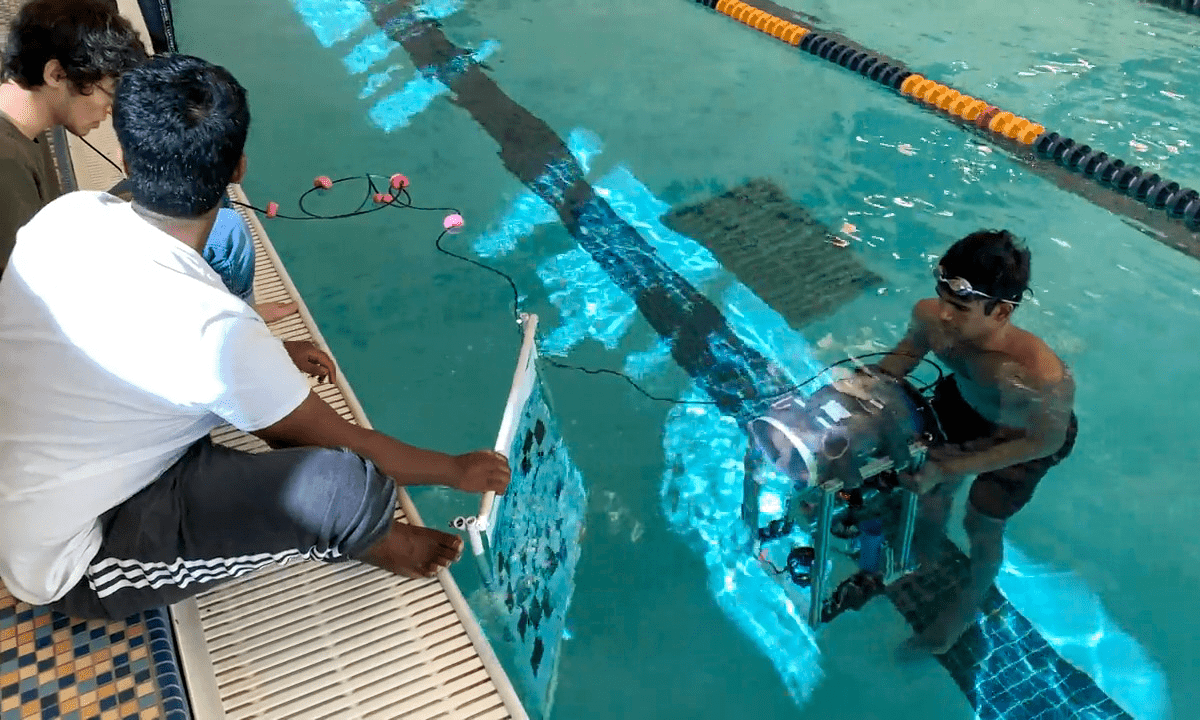 The Aerospace Systems Design Lab's Marine Robotics uses Systems Research to Develop Autonomous Boats
The Aerospace Systems Design Lab's Marine Robotics uses Systems Research to Develop Autonomous Boats
Self-driving cars promise to revolutionize public transportation, avoid accidents, and make the driving experience more pleasant. But what about self-driving boats? How do engineers create boats that dock, monitor their surroundings and navigate tumultuous seas, all autonomously – that is, without the intervention of their human creators? Marine Robotics is answering this question and winning prizes while doing it.
The organization, which operates out of the Aerospace Systems Design Lab in the Guggenheim School of Aerospace Engineering, is both a research group and chartered student club that works on three autonomous vehicles that operate beneath and on the surface of the water. Separate teams work on each project: the RoboBoat, RoboSub, and RobotX. Each team competes in international competitions that require the autonomous vehicles to complete complex tasks without a human at the helm.
Watch the Marine Robotics team in action as they test their RoboSub's image recognition capabilities.
Anshul Sinha, a fourth-year mechanical engineering student and current treasurer of Georgia Tech Marine Robotics, has been involved since his first-year, when he got the chance to redesign the RoboBoat from scratch. It was his first introduction to the engineering design process.
“Building boats is not something that you learn in class,” Sinha said. “I went through design reviews, different versions, and showed a bunch of the grad students my ideas. It was super fun because I got to learn a whole new process.”
During competitions, each aquatic vehicle is required to complete a set of challenges that are based on real-life maritime scenarios, like detecting underwater noises and navigating towards them, avoiding obstacles, docking at a specific location or launching a drone to see something from above. As a result, students gain skills that are very desirable to organizations like the US Navy and private maritime companies. The same concepts used in this college club can be applied to cutting-edge technologies, like autonomous police boats for monitoring coastlines. Oceanographers are also interested in using these advances to help map the sea floor features.
Each autonomous vehicle must work as a self-sufficient system, coordinating many moving parts to accomplish a goal. The group's advisor, ASDL research engineer Michael Steffens says the work is closely tied to his research in systems design.
“A lot of the techniques developed in aerospace engineering apply to complex systems: operating and fielding multiple systems at the same time, getting them to collaborate and work together,” said Steffens. “The maritime environment actually is a very forgiving environment compared to flying systems, because if your system stops working or gets lost or gets confused, it just floats as opposed to falling out of the sky.”

The RoboSub team spent a day at the Campus Recreation Center pool testing the sensing capabilities of their autonomous submarine.
The system itself must be multifaceted and adaptable, and the same is true for the team working on each project. Students from nearly every college at Georgia Tech get involved because of the opportunity for hands-on experiences and knowledge building outside the limits of their majors.
“We are a small lab, but we have a lot of equipment, so everyone gets to dabble,” said Sinha, who was just a first-year student at the time he helped charter the club as student organization in 2017. “So even if you're a mechanical engineer, you get to learn the basics of how autonomy works. You get to learn how to code if you want to. You get to learn how to do a lot of the electronics, or networking, or navigation if that's what you want to do.”
Both learning and teaching are key facets of Georgia Tech Marine Robotics. Sinha and other experienced students host sessions to teach new members skills like the basics of computer aided design (CAD) or how to use a machine to mill the hull of the boat. He remembers what it was like to be a first-year and be passionate about getting involved in projects on campus. Winning international competitions doesn’t hurt when trying to recruit new students, he added.
When it comes to competitions, the Georgia Tech Marine Robotics RoboBoat team secured a podium spot every year from 2016 to 2018. They have also won awards for the RobotX and RoboSub divisions, and the prize money helps them to improve their boat every year. Sinha says that he hopes incoming students will be able to continue Georgia Tech’s legacy of developing complex autonomous systems and showing them off at competitions.
Story courtesy of Polly Ouellette